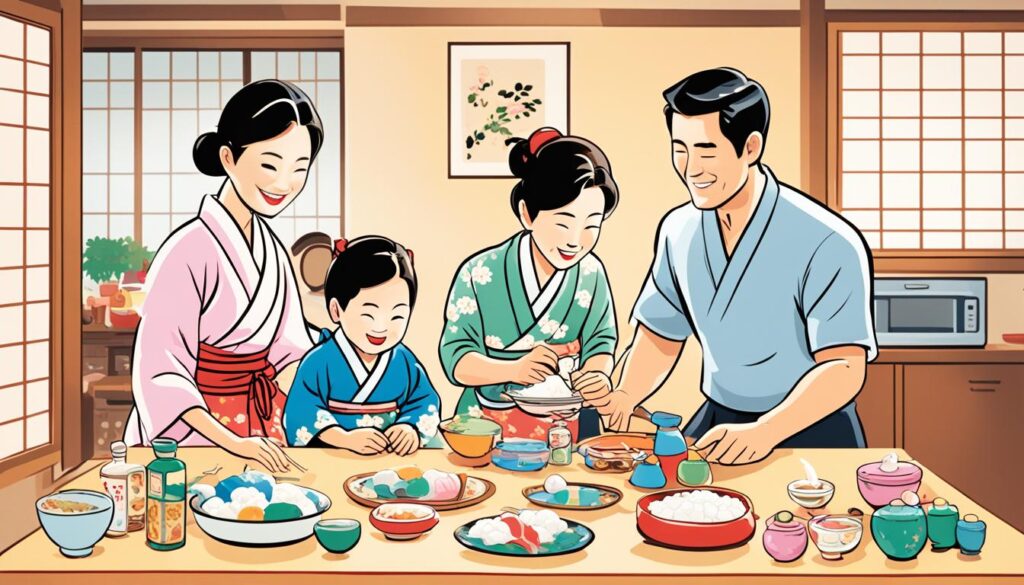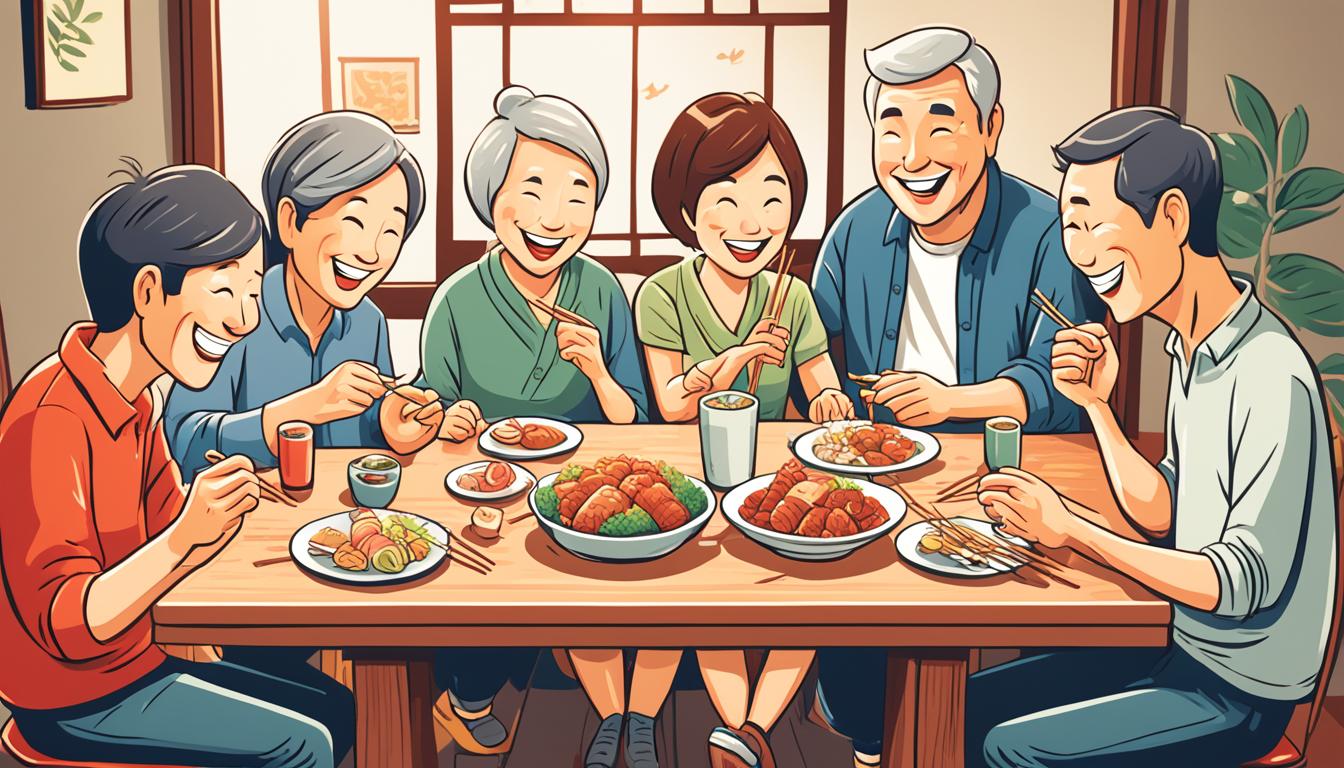Welcome to our article on “kazoku,” the Japanese term for family. In this piece, we will explore the meaning and grammar of this word, along with its pronunciation and equivalents in other languages. Additionally, we will delve into the contextual and cultural usage of “kazoku” in Japan.
When it comes to family structures, language plays a significant role in reflecting cultural values and societal norms. “Kazoku” encapsulates the concept of family in Japanese culture and holds deep meaning for the Japanese people.
In Japanese grammar, “kazoku” is a noun that refers to the family as a collective unit. It encompasses both immediate and extended family members, highlighting the importance of kinship and the interconnectedness of family relationships.
To pronounce “kazoku,” break it down into syllables: “ka-zo-ku.” The first syllable “ka” sounds like “car,” while the second syllable “zo” rhymes with “go.” The third syllable “ku” is pronounced as “coo.” When pronounced together, it sounds like “kah-zoh-koo.”
While there is no direct equivalent word for “kazoku” in English, it can be loosely translated as “family” or “household.” However, it is crucial to note that the cultural context and nuances associated with “kazoku” extend beyond a simple translation.
When writing the term “kazoku” in kanji, it is represented by the characters 家族, which literally translate to “family” and “tribe.” These characters capture the essence of the collective identity and shared responsibilities within a Japanese family.
In Japanese society, kazoku plays a vital role in shaping social roles, responsibilities, and customs. The traditional Japanese family structure, known as the “ie,” emphasizes a multi-generational household with a patriarchal head. Family members are expected to prioritize the interests of the family as a whole, reinforcing the sense of unity and obligation.
However, with the modernization of Japanese society, the concept of family has evolved. Nuclear families consisting of two parents and their children are becoming more common, reflecting a shift towards a more individualistic society. Nevertheless, the cultural significance of family relationships remains strong, and the importance of maintaining harmonious ties with relatives is deeply ingrained.
So, now that we have laid the foundation of understanding “kazoku,” let’s dive deeper into the family roles and values in Japanese culture in the next section.
Family Roles and Values in Japanese Culture
In Japanese culture, family roles and values hold significant importance. The traditional Japanese family structure, known as the “ie,” follows a patriarchal household with multiple generations living together. Family members are expected to prioritize the collective interests of the family, with the eldest son often assuming the responsibility of caring for the parents.
The influence of Confucianism plays a crucial role in shaping Japanese family dynamics. Confucianism emphasizes the importance of seniority and respect for elders, reinforcing the significance of kinship and loyalty within the family.
Table: Japanese Family Structure
| Family Roles | Key Characteristics |
|---|---|
| Patriarch | Serves as the head of the household and responsible for making important decisions. |
| Eldest Son | Traditionally expected to care for the parents as they age. |
| Mother | Often takes charge of household management and child-rearing. |
| Extended Family | Multi-generational members living together to maintain family unity. |
While modern Japanese society has witnessed a shift towards nuclear families, the cultural significance of family relationships remains strong. Despite evolving family structures, the value placed on kinship, loyalty, and respect for elders is deeply rooted in Japanese culture.
The Kazoku Peerage System in Japan
The Kazoku was the hereditary peerage system in the Empire of Japan from 1869 to 1947. It replaced the feudal lords and court nobles and was created as a social and political support for the emperor and the imperial institution. The kazoku consisted of different ranks, including prince, marquess, count, viscount, and baron. The rank distribution was based on the highest office held by the ancestors of the kazoku members. The kazoku registry, known as the koseki, played a significant role in recording and maintaining family details.
In the Kazoku peerage system, the prince was the highest rank, followed by marquess, count, viscount, and baron. The ranks were hereditary, meaning they were passed down through generations within the noble families. These hereditary peers held significant privilege and influence in Japanese society.
The Kazoku registry, or the koseki, was a vital record-keeping system that documented the family lineage and status within the kazoku. It included information about the ranks, titles, and other pertinent details of each family. The koseki provided a foundation for maintaining order and hierarchy within the peerage system.
The kazoku system played a crucial role in the social and political fabric of imperial Japan. It provided the emperor with a network of loyal supporters and officials, ensuring stability and cohesion within the ruling class. However, with the changing times and the post-war democratic reforms in Japan, the kazoku system was abolished in 1947, and the hereditary peerage was dissolved. Today, the legacy of the kazoku peerage system remains in historical records and cultural significance.
Changes in Japanese Family Structures
Japanese family structures have been undergoing significant changes in recent years. The country is facing the challenges posed by an ageing population, high life expectancy, and low fertility rate. As a result, families in Japan are characterized by a higher proportion of elderly relatives compared to children.
This demographic shift has led to a growing need for elderly care in Japan. With the responsibility often falling on the younger generation, a phenomenon known as “elderly caring for elderly” has emerged. This presents unique challenges for families as they navigate the complexities of providing care while balancing their own personal and professional lives.
Household units in Japan typically consist of two-generational households, where both parents are working. However, it is worth noting that the husband’s involvement in family life may decrease after having children. Despite advancements in gender roles, traditional expectations still persist in some segments of society.
In terms of gender roles, more women are joining the workforce in Japan. This trend has alleviated some of the burden previously placed on men as the sole income-earners. However, challenges remain in achieving work-life balance and gender equality, as societal expectations and workplace norms can hinder women’s career progression and participation in decision-making processes.
Below is a table summarizing the key factors related to the changing family structures in Japan:
| Key Factors | Description |
|---|---|
| Ageing population | Japan has a significant proportion of elderly individuals, leading to a shift in family dynamics. |
| Low fertility rate | The decline in the number of children being born contributes to the shrinking size of Japanese families. |
| Elderly care | The responsibility of caring for elderly relatives often falls on the younger generation. |
| Two-generational households | Households typically consist of two generations living together, with both parents working outside the home. |
| Gender roles | Traditional gender roles persist, but there has been a gradual shift towards more women joining the workforce. |
In conclusion, the changing family structures in Japan are a reflection of the country’s ageing population, low fertility rate, and evolving gender roles. These shifts present unique challenges and opportunities for families in Japan as they strive to adapt to the changing social and economic landscape.
Gender Roles and Expectations in Japanese Families

Japanese society has long been characterized by traditional gender roles and expectations within families. Historically, fathers were seen as the primary breadwinners, responsible for financial support, while mothers were expected to focus on household management and child-rearing. This division of labor reflected societal norms and cultural expectations.
In recent decades, there has been a shift in gender dynamics, with more women entering the Japanese workforce. This change has been driven by factors such as increased education levels for women and the need for dual incomes to support families in modern times. However, despite these advancements, women still face significant challenges when rejoining the workforce after raising children.
Many women find themselves concentrated in part-time or low-paying jobs, which often offer limited opportunities for career growth and financial independence. The gender wage gap remains a persistent issue, with women earning less than their male counterparts for similar work. These challenges can serve as barriers for women attempting to reenter the workforce or pursue fulfilling career paths.
Furthermore, single-parent households, predominantly headed by women, face additional financial and caregiving pressures. Balancing work and family responsibilities can be particularly challenging in such situations. Single mothers often have to navigate limited support systems and rely on their own resilience to make ends meet and provide for their children.
Efforts have been made in Japan to address gender inequalities and promote greater gender equality. Initiatives have been launched to improve work-life balance, provide support for working mothers, and create more inclusive work environments. However, social expectations and stigmas around gender continue to persist, creating barriers for women in achieving true equality in both family dynamics and the workforce.
| Challenges faced by women in Japanese families and the workforce | Solutions and initiatives |
|---|---|
| Limited opportunities for career advancement and financial independence due to concentration in part-time or low-paying jobs | – Promoting workplace diversity and inclusion to support women in leadership roles – Implementing policies to narrow the gender wage gap – Offering childcare support and flexible work arrangements to support working mothers |
| Difficulties for women rejoining the workforce after raising children | – Providing access to affordable and quality childcare facilities – Introducing policies to support work-life balance, such as parental leave and flexible working hours |
| Financial and caregiving pressures faced by single-parent households, predominantly headed by women | – Expanding social support systems for single parents – Creating educational and job training programs to enhance employability and financial stability for single mothers |
Dating, Marriage, and Family Dynamics in Japan
When it comes to dating and marriage customs in Japan, the younger generation typically starts dating in their late teens or early twenties. The process of finding a potential partner can occur through various avenues, including university, friends, or group blind dates known as “gokon.” These gatherings provide an opportunity for individuals to meet and socialize in a casual setting.
Weddings hold significant importance in Japanese culture as they symbolize the union of two families. Traditional Japanese weddings, rooted in Shinto traditions, are revered for their rich cultural rituals and symbolism. However, Western-style white weddings have also gained popularity in recent years. These contemporary ceremonies often blend Japanese and Western elements, reflecting the country’s modernization and global influence.
While Japan has made progress in many areas of social acceptance, same-sex relationships still face legal constraints. Currently, same-sex marriage is not recognized at a national level in Japan. However, local governments have taken steps towards recognizing same-sex partnerships and providing certain rights and benefits. This indicates a gradual shift in societal attitudes and recognition of diverse relationships.
Although divorce rates in Japan have been steadily increasing, divorce itself remains relatively uncommon compared to some other countries. Economic pressures and social stigmas surrounding divorce contribute to the lower divorce rates. Despite the challenges, efforts are being made to address issues related to marriage and family dynamics in Japan, aiming to create a more inclusive and supportive environment for all individuals and relationships.

